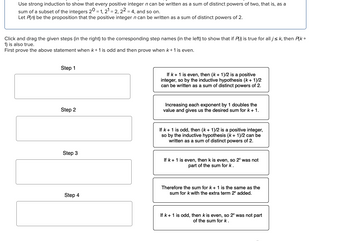
Advanced Engineering Mathematics
10th Edition
ISBN: 9780470458365
Author: Erwin Kreyszig
Publisher: Wiley, John & Sons, Incorporated
expand_more
expand_more
format_list_bulleted
Question

Transcribed Image Text:Use strong induction to show that every positive integer n can be written as a sum of distinct powers of two, that is, as a
sum of a subset of the integers 20 = 1, 21 = 2, 22 = 4, and so on.
Let P(n) be the proposition that the positive integer n can be written as a sum of distinct powers of 2.
Click and drag the given steps (in the right) to the corresponding step names (in the left) to show that if P() is true for all j≤ k, then P(k+
1) is also true.
First prove the above statement when k + 1 is odd and then prove when k + 1 is even.
Step 1
Step 2
Step 3
Step 4
If k + 1 is even, then (k+ 1)/2 is a positive
integer, so by the inductive hypothesis (k+ 1)/2
can be written as a sum of distinct powers of 2.
Increasing each exponent by 1 doubles the
value and gives us the desired sum for k + 1.
If k+ 1 is odd, then (k+ 1)/2 is a positive integer,
so by the inductive hypothesis (k+ 1)/2 can be
written as a sum of distinct powers of 2.
If k + 1 is even, then k is even, so 2° was not
part of the sum for k
Therefore the sum for k+ 1 is the same as the
sum for k with the extra term 2º added.
If k+ 1 is odd, then k is even, so 2° was not part
of the sum for k.
Expert Solution
This question has been solved!
Explore an expertly crafted, step-by-step solution for a thorough understanding of key concepts.
This is a popular solution
Trending nowThis is a popular solution!
Step by stepSolved in 3 steps with 2 images

Knowledge Booster
Similar questions
- Let k be a positive integer. Use induction to prove that (k – 1)"+1+k2n-1 is divisible by k2 – k+1 for every positive integer n.arrow_forwardUse proof by contraposition to prove this. If n is an integer and 3n is not a multiple of six, then n is odd.arrow_forwardProve: Any positive integer can be represented as an aggregate of different powers of 3, the terms in the aggregate being combined by the signs + and - appropriately chosen.arrow_forward
- Use induction to prove that for every integer n ≥ 0, 5n+2+ 62n+1 is divisible by 31.arrow_forwardLet S be the subset of the set of ordered pairs of integers defined recursively by Basis step: (0,0) = S F Recursive step: If (a, b) = S, then (a, b + 1) = S, (a + 1, b + 1) = S, and (a + 2, b + 1) = S. List the elements of S produced by the first four applications of the recursive definition. Enter your answers in the form (a₁, b₁), (a2, b2),..., (an, bn), in order of increasing a, without any spaces. The first application of the recursive step adds (Click to select) ✓to S. The second application of the recursive step adds (Click to select) The third application of the recursive step adds (Click to select) The fourth application of the recursive step adds (Click to select) to S. ✓to S. ✓to S.arrow_forwardGiven an integer N with an odd number of digits. Let M be the integer formed by reversing the order of the digits.(for example, if N = 123, then the integer formed by reversing the order of the digits of N is M = 321).Show that (N) power 11- (M) power 11 is divisible by 11.arrow_forward
arrow_back_ios
arrow_forward_ios
Recommended textbooks for you
 Advanced Engineering MathematicsAdvanced MathISBN:9780470458365Author:Erwin KreyszigPublisher:Wiley, John & Sons, Incorporated
Advanced Engineering MathematicsAdvanced MathISBN:9780470458365Author:Erwin KreyszigPublisher:Wiley, John & Sons, Incorporated Numerical Methods for EngineersAdvanced MathISBN:9780073397924Author:Steven C. Chapra Dr., Raymond P. CanalePublisher:McGraw-Hill Education
Numerical Methods for EngineersAdvanced MathISBN:9780073397924Author:Steven C. Chapra Dr., Raymond P. CanalePublisher:McGraw-Hill Education Introductory Mathematics for Engineering Applicat...Advanced MathISBN:9781118141809Author:Nathan KlingbeilPublisher:WILEY
Introductory Mathematics for Engineering Applicat...Advanced MathISBN:9781118141809Author:Nathan KlingbeilPublisher:WILEY Mathematics For Machine TechnologyAdvanced MathISBN:9781337798310Author:Peterson, John.Publisher:Cengage Learning,
Mathematics For Machine TechnologyAdvanced MathISBN:9781337798310Author:Peterson, John.Publisher:Cengage Learning,


Advanced Engineering Mathematics
Advanced Math
ISBN:9780470458365
Author:Erwin Kreyszig
Publisher:Wiley, John & Sons, Incorporated

Numerical Methods for Engineers
Advanced Math
ISBN:9780073397924
Author:Steven C. Chapra Dr., Raymond P. Canale
Publisher:McGraw-Hill Education

Introductory Mathematics for Engineering Applicat...
Advanced Math
ISBN:9781118141809
Author:Nathan Klingbeil
Publisher:WILEY

Mathematics For Machine Technology
Advanced Math
ISBN:9781337798310
Author:Peterson, John.
Publisher:Cengage Learning,

